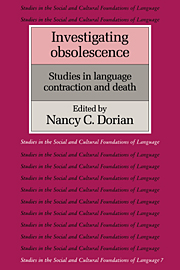Book contents
- Frontmatter
- Contents
- List of maps
- List of contributors
- Preface
- Map
- Dedication
- Introduction
- I Focus on context
- II Focus on structure
- III Invited commentaries
- 21 Some people who don't talk right: Universal and particular in child language, aphasia, and language obsolescence
- 22 Language obsolescence and language history: Matters of linearity, leveling, loss, and the like
- 23 Language convergence and language death as social processes
- 24 Pidgins, creoles, immigrant and dying languages
- 25 The “up” and “down” staircase in secondary language development
- Bibliography
- Index of languages
- General index
25 - The “up” and “down” staircase in secondary language development
Published online by Cambridge University Press: 08 January 2010
- Frontmatter
- Contents
- List of maps
- List of contributors
- Preface
- Map
- Dedication
- Introduction
- I Focus on context
- II Focus on structure
- III Invited commentaries
- 21 Some people who don't talk right: Universal and particular in child language, aphasia, and language obsolescence
- 22 Language obsolescence and language history: Matters of linearity, leveling, loss, and the like
- 23 Language convergence and language death as social processes
- 24 Pidgins, creoles, immigrant and dying languages
- 25 The “up” and “down” staircase in secondary language development
- Bibliography
- Index of languages
- General index
Summary
The primary objective of second language acquisition (SLA) research is to uncover the principles which govern the process by which someone moves from no knowledge of a second language through various intermediate “stages” towards near-native control of the second language. This book provides an opportunity to view some of these principles from a different vantage point as well as an opportunity possibly to provide some new insights into the process of language obsolescence.
The standard view of second language acquisition (by immigrants and their children) makes it seem as if the chronologically first-acquired language will always be totally native and “successful” and any subsequent languages will be nonnative and often unsuccessfully acquired. The cases discussed in this volume show how one-sided the standard view of SLA is: SLA often proceeds the way it does because of inadequate access to and interaction with the people who speak and use the “second” language as their primary, fully-developed native language, not just because it is not the native (“first”) language of the learner. Immigrants typically have restricted access to the situations where they can successfully acquire the language of the country to which they have immigrated. Second- and third-generation speakers of a contracting or dying language are similarly limited in their access to the type of linguistic input and interaction that is necessary for them to become or remain competent speakers of their ancestral language. From this perspective, languages being partially acquired and dying languages seem very similar. My purpose in this commentary is to suggest why they are so similar.
- Type
- Chapter
- Information
- Investigating ObsolescenceStudies in Language Contraction and Death, pp. 385 - 394Publisher: Cambridge University PressPrint publication year: 1989
- 4
- Cited by



